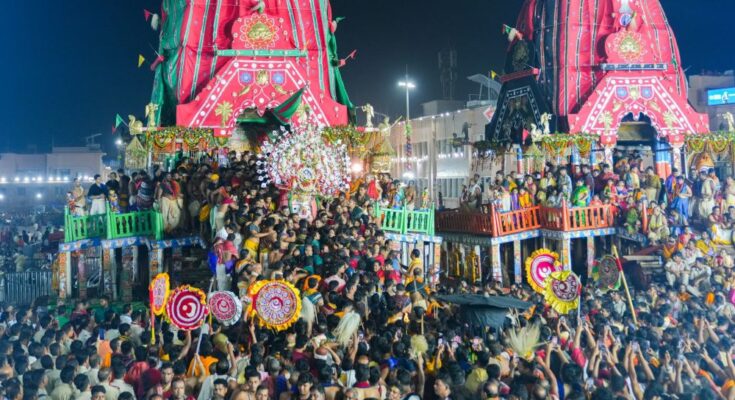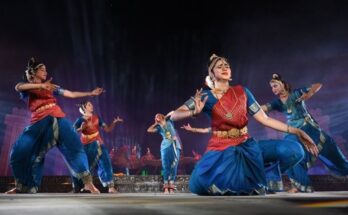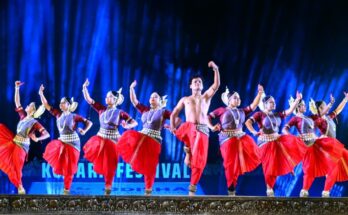Dr. Fakira Mohan Nahak
The world-famous Rath Yatra of Lord Jagannath in Puri is a festival steeped in devotion, tradition, and rich cultural heritage. Spanning several days, it marks the annual ceremonial journey of Lord Jagannath, Lord Balabhadra, and Devi Subhadra from the Shri Jagannath Temple to the Gundicha Temple. Among the many significant rituals associated with this sacred yatra, Neeladri Bije holds a special place as the concluding event that signifies the Lord’s triumphant return to His sanctum. Interestingly, this divine homecoming is also linked to a delightful culinary tradition — the offering of Rasagola, celebrated as Rasagola Dibasa.
Neeladri Bije is the final ritual of the Rath Yatra festival. After spending eight days at Gundicha Temple, the deities journey back to the Shri Mandira on their majestic chariots during Bahuda Yatra. Then on Harishayan Ekadashi deities are adorned with Suna Besha or Rajarajeshwar Besha. The Adhara Pana ritual is performed on the Dwadashi Tithi (12th day) of the bright fortnight of the Ashadha month. The next day on Trayodashi Tithi deities return to the sanctum sanctorum of Shri Mandira. However, upon reaching the temple gates, Lord Jagannath faces a playful yet symbolic obstruction by Mahalakshmi, His consort. According to tradition, Devi Mahalaxmi feels slighted for being left behind during the Lord’s journey to Gundicha Temple. In an enactment of marital drama symbolizing conjugal love and understanding, the Goddess initially denies Lord Jagannath entry into the temple.
To appease her, Lord Jagannath performs a series of rituals, one of which is offering Rasagolas, the soft, syrupy cottage cheese delicacies, to Devi Mahalaxmi. This act melts the Goddess’s heart, and she finally allows Him to enter the temple. With this reconciliation, Neeladri Bije concludes, marking the end of the Rath Yatra festivities. The tradition of offering Rasagola to Mahalaxmi during Neeladri Bije is several centuries old, as recorded in Odia temple chronicles known as Madala Panji.
The playful quarrel and sweet reconciliation between Lord Jagannath and Devi Mahalaxmi during Neeladri Bije symbolize important human emotions like love, longing, and reunion. It reflects how even the divine experiences the subtleties of relationships, teaching devotees lessons in understanding, patience, and harmony. Moreover, by offering the sweet Rasagola, Lord Jagannath not only pacifies Mahalaxmi but also upholds the Odia tradition of using sweets as a medium to express love, apology, and celebration.
Rasagola Dibasa: A Celebration of Sweet Devotion
The tradition of offering Rasagolas during Neeladri Bije has inspired the modern observance of Rasagola Dibasa (Rasagola Day). Celebrated on the day of Neeladri Bije, it honours Odisha’s age-old culinary and cultural association with this iconic sweet.
Rasagola Dibasa was first celebrated on July 30, 2015, by Odias worldwide via social media to assert their historical claim over the sweet’s origin and to highlight its integral role in Jagannath culture. It gained momentum nationwide, becoming a matter of cultural pride.
Neeladri Bije is more than a concluding ritual — it’s an emotional, cultural, and spiritual crescendo of the Rath Yatra festival. The bond between Jagannath and Mahalaxmi, the offering of Rasagola, and the celebration of Rasagola Dibasa together represent a harmonious blend of faith, festivity, and flavour.
Each year, as devotees witness the grand spectacle of Neeladri Bije, they not only celebrate the Lord’s return to His abode but also reaffirm the timeless connection between ritualistic devotion and culinary heritage that has sweetened Odisha’s spiritual landscape for generations.
(Dr. Fakira Mohan Nahak, Professor, Journalism and Mass Communication, Manipal University Jaipur, Rajasthan,
Call- 9937252464)




